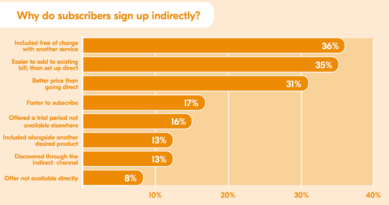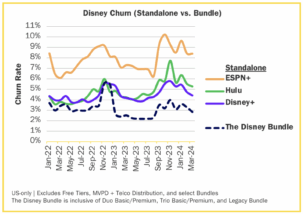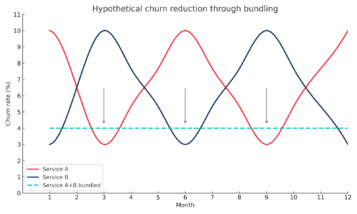Customer retention: Reducing churn through multi-party bundles
by Giles Tongue | 29 Jul 2025

In part 1 of this blog, we examined the fight for customer acquisition. In part 2, we look at how bundling is being used in the fight against churn.
In the recent Subscriptions Assemble report by Bango, subscribers who are taking a third of their subscription through indirect channels, cited reasons of ease, simplicity and price as top reasons to subscribe through indirect channels.

The savvy subscriber
In the same report Bango identified that 68% of subscribers are now shopping around for best prices before signing up to new subscriptions, 39% use an app, website or browser to help identify the best deals and 36% are frequently pausing and restarting subscriptions.
The subscriber has become sophisticated in how and where they subscribe, and for how long they stay subscribed to a service.
Multi-party bundles for churn reduction
Evidence provided by Antenna show that multi-party bundles can contribute to churn reduction. In the State of Subscriptions report by Antenna last year, it was shown that in a few different examples, when services were sold together in a bundle, they had greater stickiness than when the same products were sold as individual subscriptions.
If we compare the Disney+/ESPN+/Hulu bundle with the standalone churn rates for the same services, we see that in the case of ESPN+ the bundle reduced churn from around 8% to just 3%.

In a Wall Street Journal article Ampere Analysis state that this bundle after the first 3 months had retained 80% of its subscribers, making at stickier than Netflix at the time (74%), the industry leader.
Ampere Analysis in SVOD Economics US took a look at the same bundle and found that the Disney+ 6 month churn rate was 43%, falling to just 19% when part of the Disney Bundle.
Co-opetition already in market
In part 1, we looked at various examples such as Disney+/Hulu/HBO Max, where competition organizations are now bundling together and selling each other’s products.
With the above data from Antenna, a logical question to propose as the bundle economy evolves is…
Can bundling be the antidote to churn?
One hypothesis we’re interested in exploring is whether bundling two products with seasonal or event-driven churn – such as sports-oriented content – could improve stickiness (i.e., reduce churn) when presented together. By combining a “peaky” service like sports with another offering that appeals to sports fans but follows a different seasonal pattern, might we raise the tide for both and enhance overall retention?

Similarly, could bundling a subscription product with seasonality, with a product that has less seasonality, improve churn for both?

And how about products that have a short useful lifetime, such as a tool that solves an infrequently occurring issue?
Could bundling extend a product’s lifetime?
If a service with short tenure is bundled with one that retains customers longer, the overall subscriber tenure may improve. For example, Service A, while an important service, might have a short usage, while Service B is used over a longer period. Together, their combined value could lead to longer engagement. Offering a discount is often necessary, but the key question is whether the gain in subscriber longevity offsets the margin loss.

Conclusion
Much like in part 1 – where we explored the potential of multi-party bundling as a strategy for customer acquisition – here we’ve turned our attention to its role in reducing churn. In particular, for services with event-driven or seasonal usage patterns, bundling may offer a powerful way to smooth out engagement cycles and retain customers longer.
We’re only at the beginning of what’s possible in the bundle economy. Today, testing new bundled offers in the market has never been simpler. The ability to combine complementary services – targeting a shared audience – is now more accessible than ever, unlocking new opportunities for mutual growth.
The Digital Vending Machine® (DVM™) from Bango is enabling this next wave of collaboration. By making it easy for companies to partner and bundle services, it paves the way for multi-party bundling to become a true antidote to churn.
Missed part 1?
We explore the case for multi-party bundling being used for customer acquisition
That’s a bundle!
Celebrating unusual and unexpected bundles. Take a look and let us know which you like the most!
Subscribe to our newsletter
Get the latest subscription bundling news and insights delivered straight to your inbox.



